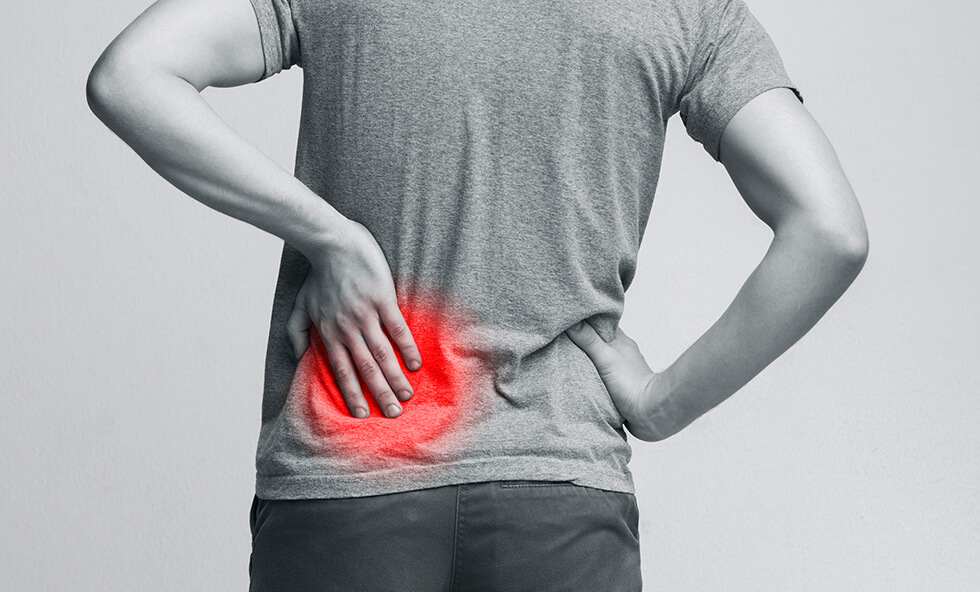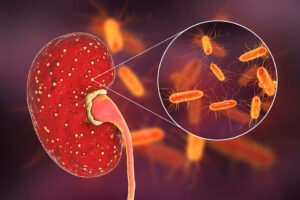Kidney Infection

A kidney infection is a type of urinary tract infection (UTI) that affects one or both kidneys. It can be painful, serious, and, in some cases, life-threatening.
Actually, the term urinary tract infection can refer to an infection anywhere in the urinary tract, including the urethra, bladder, kidneys, and ureters (tubes that connect the kidneys to the bladder). Kidney infection is a more specific term and refers to infection in the kidneys. Sometimes a kidney infection is called a renal infection or pyelonephritis.
The Urology Care Foundation estimates that about 1 in 30 UTIs eventually become kidney infections.
What do the kidneys do?
The kidneys are two fist-sized, bean-shaped organs located below the rib cage. There is one kidney on each side of the spine.
Every minute, the kidneys clean about a half cup of blood, filtering out wastes and water in the form of urine. Urine then flows from the kidneys to the bladder through
the ureters.
The kidneys also keep fluids and electrolyte levels in balance, help regulate blood pressure, and contribute to good bone health.
What causes kidney infections?

Like UTIs, most kidney infections begin in the urethra—the tube that allows urine to flow out of the body. When bacteria or viruses enter the urethra, they can travel up the urinary tract and into the bladder. From there, they can move even further and reach the kidneys.
E. coli, a type of bacteria that lives in the bowel, is a common cause of kidney infections.
It’s also possible for bacteria or viruses in the blood to flow into the kidneys and cause an infection.
What are the risk factors for kidney infections?
The Urology Care Foundation estimates that about 1 in 30 UTIs eventually become kidney infections.
Here are some of the most common risk factors for kidney infections:
A history of UTIs. People who have had a UTI before, especially during the previous 12 months, are more likely to develop a kidney infection.
Family history of UTIs. If a parent, sibling, or child has had a UTI, a person may be at higher risk, too.
Being female. Women have shorter urethras than men do, so bacteria have a shorter route to the bladder and kidneys. For this reason, women are more likely to have kidney infections.
Pregnancy. Some scientists think that hormonal changes or changes in the urinary tract during pregnancy might increase kidney infection risk.
Structural problem with urinary tract. Issues like kidney stones, tumors, or a narrowed urethra can block or change the normal flow of urine. If this occurs, bacteria may linger in the urinary tract.
Surgical procedures or medical devices. While surgeons take every precaution, bacteria can enter the urinary tract during surgery or while a medical device, such as a catheter, is in use.
Vesicoureteral reflux (VUR). This condition causes urine to flow backwards from the bladder back to the kidneys instead of out the urethra. When this happens, bacteria can remain in the urinary tract.
Diabetes. Diabetes can cause sensory problems, making it difficult for a person to “know” that they need to urinate. In this case, urine may stay in the bladder longer than it should, fostering bacterial growth that could spread to the kidneys.
A weakened immune system. People may be at higher risk for kidney infections if their immune system has been weakened, such as by cancer, HIV, an organ transplant, or a low white blood cell count.
Spinal cord injury or nerve damage. In this case, a person may be unable to feel the physical symptoms of a UTI and the infection can spread.
Urinary retention. Urinary retention occurs when a person can’t empty their bladder completely. Bacteria could remain in the bladder and travel to the kidneys.
Frequent sex or a new sex partner. Viruses and bacteria can be easily transmitted during sexual activity because the urethra is so close to the genitals. Also, new sex partners might not be aware of each other’s infection history.
Spermicides. Many women use spermicides for birth control. However, spermicides can disrupt the balance of “good” and “bad” bacteria in the vagina, making it more likely that UTI-causing bacteria will enter the urethra.
What are the symptoms of a kidney infection?
Kidney infections might have some or all of these symptoms:
- Chills
- Fever
- Pain in back, side, groin, or pelvis
- Nausea or vomiting
- Cloudy, dark, bloody, or smelly urine
- Frequent urination
- Painful urination (for example, a burning sensation)
- An urgent need to urinate
However, kidney infection symptoms can vary depending on a person’s age. For example, children younger than 2 may have only a high fever. And adults aged 65 and over may become confused, have hallucinations, or have trouble speaking.
People who think they may have a kidney infection should see a doctor right away.
Kidney infections should be treated as quickly as possible. Without proper treatment, they can cause kidney damage and lead to kidney disease or kidney failure.
What are the potential complications of kidney infections?
Kidney infections should be treated as quickly as possible. Without proper treatment, they can cause kidney damage and lead to kidney disease or kidney failure. High blood pressure can also result from a kidney infection. In severe cases, sepsis is possible. (Sepsis is a life-threatening condition that can be caused by a bacterial infection already in the body. It can lead to severe organ damage and failure.)
How are kidney infections diagnosed?
Health care providers run a variety of tests to diagnose a kidney infection:
Medical history. A doctor will assess symptoms and their severity as well as past health conditions, including any history of UTIs.
Physical exam. By gently pressing the abdomen, a doctor can check levels of pain or discomfort. Men may also have a digital rectal exam (DRE) to see whether the prostate is swollen and blocking the bladder neck. Women may have a pelvic exam.
Urinalysis. A urine sample will be checked for bacteria and other substances that could contribute to an infection.
Urine culture. This test can help determine what kind of bacteria is causing the infection. This information guides treatment decisions, such as what type of antibiotic to prescribe.
Blood test. A blood sample could reveal bacteria or a higher level of white blood cells, which help the body fight infection.
Imaging tests. Usually, imaging tests aren’t needed to diagnose a kidney infection. But a doctor might order them to check for any abnormalities in the urinary tract. Some examples are a CT scan, an MRI, an ultrasound, an intravenous pyelogram, and a voiding cystourethrogram (VCUG).
How are kidney infections treated?
Like UTIs, kidney infections are usually treated with oral (taken by mouth) antibiotics. The type and duration of the prescription will depend on the type of bacteria causing the symptoms and the severity of the symptoms.
The doctor might prescribe a general antibiotic at first, which can be taken while lab tests are processed. Once the results are available, the medication might change to a different antibiotic that can target the specific type of bacteria causing the symptoms.
Very sick patients might start treatment in the hospital and receive intravenous (IV) antibiotics and fluids. Some patients receive antibiotics as injections.
Depending on the infection, the course of medicine might last several weeks.
Antibiotics should be taken exactly as prescribed for the full amount of time instructed. They shouldn’t be stopped early because a person is feeling better.
For a fever, a doctor might recommend acetaminophen or ibuprofen.
Most kidney infections clear up after a few days. In the case of recurring infections, a doctor might prescribe a daily antibiotic to prevent future infections.
Kidney infections can be particularly serious during pregnancy. For this reason, pregnant women are usually hospitalized and treated with medications that are safe for both them and their baby.
If doctors discover that a kidney stone or enlarged prostate is an issue, these conditions will be treated as well.
Should a person follow up with their doctor after a kidney infection?
After kidney infection treatment, it’s important to have a follow-up visit with the doctor. There might be further tests, like a urine culture, to make sure the infection has cleared. If the tests do show an infection, more antibiotics may be necessary.
Can kidney infections be prevented?
There are several steps a person can take to reduce their risk for UTIs and kidney infections:
Drink plenty of fluids, especially water. Drinking fluids helps flush bacteria out of the urinary system. How much fluid is recommended? The answer depends on a person’s overall health, activity level, and the weather (for example, is it a hot, humid summer day?) A doctor can advise on how much fluid to drink each day.
Don’t hold urine for too long. Try to urinate every 3 to 4 hours so that urine and bacteria don’t remain in the bladder.
Urinate after sex. Bacteria can enter the urethra through sexual activity. Urinating afterward may eliminate some of it.
Wipe from front to back. After a bowel movement, women should wipe from the front of their body to the back, toward the anus. Wiping in this direction moves bacteria away from the urethra.
Change birth control methods. Women who use spermicides or spermicide-lubricated condoms could be at higher risk for UTIs.
Resources
Centers for Disease Control and Prevention
“What is sepsis?”
https://www.cdc.gov/sepsis/what-is-sepsis.html
Cleveland Clinic
“Kidney Infection (Pyelonephritis)”
(Last reviewed: May 22, 2019)
https://my.clevelandclinic.org/health/diseases/15456-kidney-infection-pyelonephritis
EverydayHealth.com
Phillips, Quinn
“How a Kidney Infection Is Diagnosed”
(November 5, 2018)
https://www.everydayhealth.com/kidney-infection/diagnosis/
National Institute of Diabetes and Digestive and Kidney Diseases
“Kidney Infection (Pyelonephritis)”
(Last reviewed: April 2017)
https://www.niddk.nih.gov/health-information/urologic-diseases/kidney-infection-pyelonephritis/all-content
“Your Kidneys & How They Work”
(Last reviewed: June 2018)
https://www.niddk.nih.gov/health-information/kidney-disease/kidneys-how-they-work
“Urinary Retention”
https://www.niddk.nih.gov/health-information/urologic-diseases/urinary-retention
UpToDate
Hooton, Thomas M., MD
“Patient education: Kidney infection (pyelonephritis) (Beyond the Basics)”
(Topic last updated: July 15, 2020)
https://www.uptodate.com/contents/kidney-infection-pyelonephritis-beyond-the-basics
Urology Care Foundation
“Diabetes and Its Impact on Your Urinary and Sexual Health”
(Spring 2017)
https://www.urologyhealth.org/healthy-living/urologyhealth-extra/magazine-archives/spring-2017/diabetes-and-its-impact-on-your-urinary-and-sexual-health
“Kidney (Renal) Infection – Pyelonephritis”
https://www.urologyhealth.org/urology-a-z/k/kidney-(renal)-infection-pyelonephritis
“Vesicoureteral Reflux (VUR)”
https://www.urologyhealth.org/urology-a-z/v/vesicoureteral-reflux-(vur)
WebMD
Machalinski, Anne
“Best Ways to Help Prevent UTIs”
(Medically reviewed: June 2, 2020)
https://www.webmd.com/women/uti-risks
